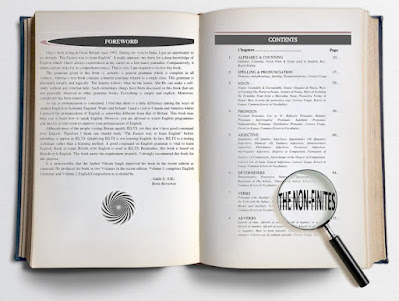A non-finite verb is a verb form which is
not acting like a verb.
There are three types of non-finite verbs:
infinitives, participles and gerunds.
(1)
Infinitives: When a verb has no
subject and then it is not limited by number and person, it simply names the
action denoted by the verb, it is called the infinitive.
The form of infinitives is ‘to+1st form of verb’ when it is in
active voice. But when it is in passive
voice, its form is ‘to be+3rd
form of verb’; as:-
a_They always try to help her.
b_It is time for her to be helped.
In
these sentences, ‘to
help’ and ‘to
be helped’ have
no subjects. Thus, not limited by number and person. Similarly observe the
following:-
a_It is possible to cross the river.
b_It is not safe for children to play on the road.
c_It was foolish of her to reject the offer.
d_It seemed impossible to go on.
e_Do you know when to begin?
f_The news proved to be false.
g_We pretended not to see her.
h_It is too hot to go outside.
i_We are near enough to see everything.
An infinitive is of two types:
1. _Simple
Infinitives
2. _Gerundial
Infinitives/ Adverb Infinitives
A_Use of simple
infinitives:
i._ As subject of verb:-
a_To err is human.
ii._As object of verb:-
a_I’m
going to tell you a story.
iii.
As complement of verb:-
a_Ask
me how to use these words.
iv._As object of preposition:-
a_We
are about to take tea.
B_Use of
gerundial infinitives/adverb infinitives:
i._ To express purpose; as:-
a_She
wants somebody to talk to.
ii._To qualify an adjective; as:-
a_Apples
are good to eat.
iii.
To qualify a noun; as:-
a_This
shop is to let.
The use of ‘to’ with the infinitives is a simple thing,
however, it is not an essential sign of infinitives. The following verbs take
the infinitives without ‘to’:
Principal verbs: can,
must, let, make, bid, dare, please, need, and also verbs denoting some kind
of perception: see, feel, hear, know, watch etc.
a_He
can run very fast.
b_Let
him stand there.
c_You
need not go there.
d_You
dare not do it.
e_I
felt her touch me.
f_Please
go there.
g_Make
her sit.
h_I
heard her sing.
Auxiliary verbs: do,
shall, will, may, might, should, would, and also when they are used as
principal verbs.
a_He
does not like her.
b_Will
you come with me?
c_We
eat that we may live.
d_You
may go.
e_I
will do it.
f_He
shall go.
The
infinitive without ‘to’ is used after had
better, had rather, had sooner, would rather, sooner than, had rather than:
a_You
had better read this book.
b_I
would rather die than suffer all this.
c_I
had rather dance than sing.
d_I
had sooner run than walk.
The
use of infinitives without ‘to’ after ‘than’,
and after ‘but’ is made in the sense
of ‘except’.
a_She
is better able to sing than dance.
b_She
did no more than weep.
c_She
did nothing but laugh and sing.






No comments:
Post a Comment